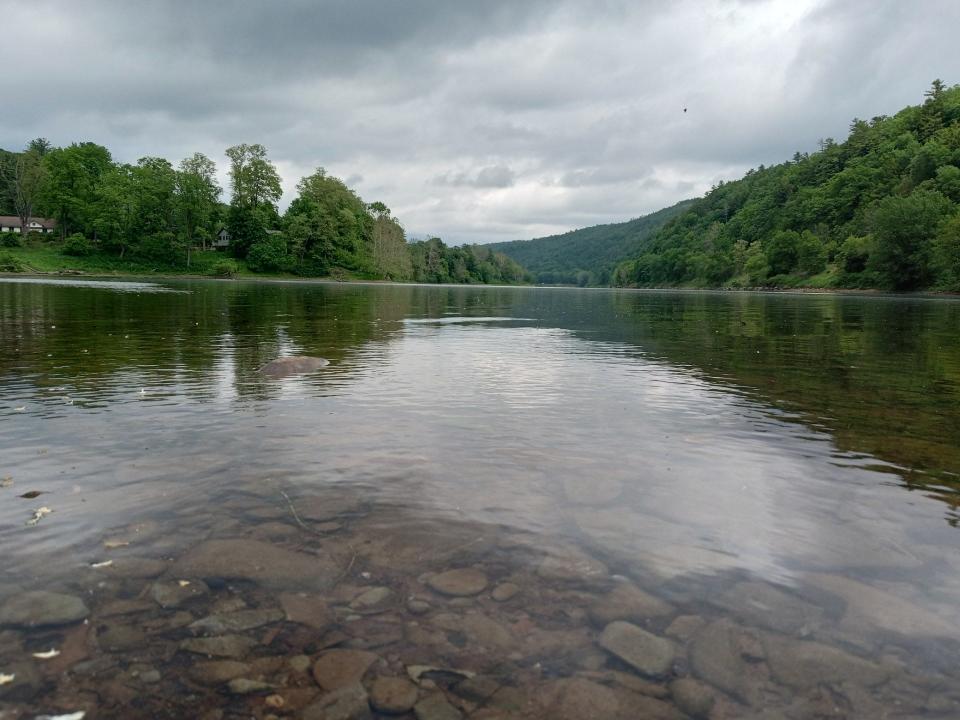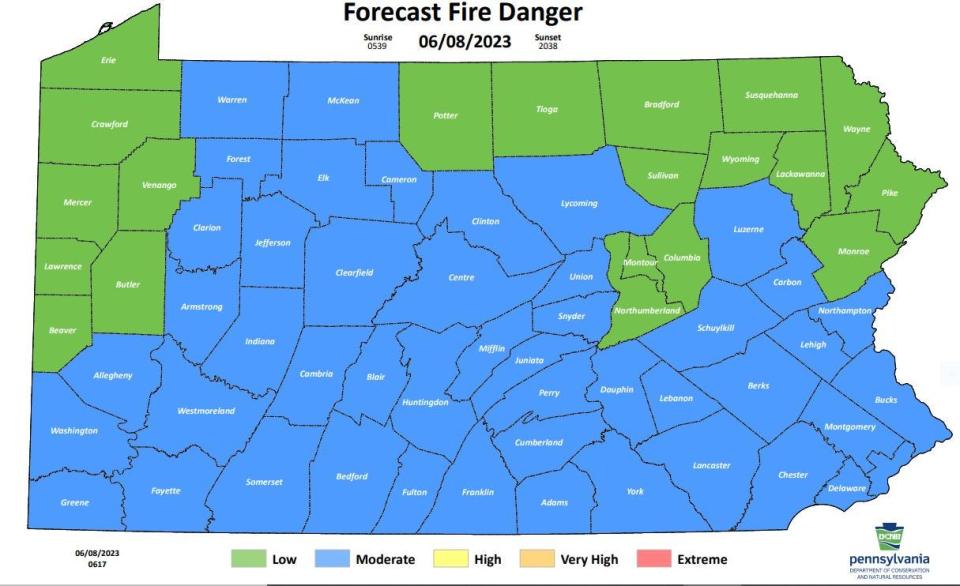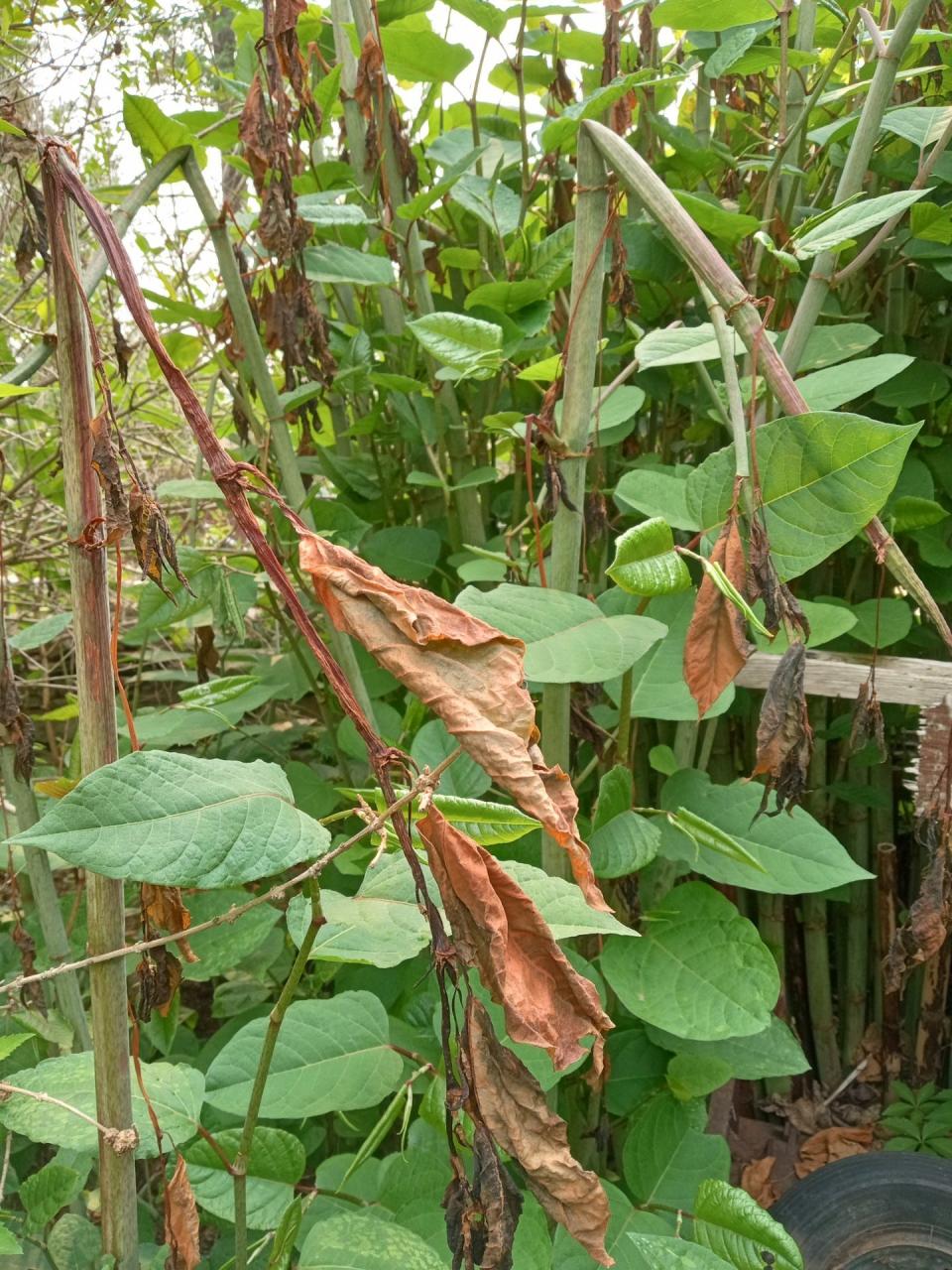Dry weather impacts life in Poconos' Delaware State Forest
Dry weather in the Upper Delaware region has kept a watchful eye on river levels while others have noted its effect on the forests of the Poconos― both its dangers and even some benefits.
Discussion about the weather impacts was heard at the Upper Delaware Council (UDC) meeting, June 1 in Narrowsburg.
The weekly Delaware River Basin Commission (DRBC) reservoir storage reports show that starting around May 15, the combined storage level of Cannonsville, Pepacton and Neversink reservoirs feeding the Upper Delaware has dropped below the long-term median. By May 30, the storage had dropped to 10.2 billion gallons (bg) below the median, which was still above DRBC's Drought Watch, by 66 bg. A year ago, however, the storage level was only 0.3 bg below median.
Another DRBC chart available on the agency's website and provided to the UDC shows how fast the Delaware River water flows in cubic feet per second (cfs). That rate is higher in times of rainy weather. As measured by the Montague gage at Milford Beach, near the tri-state point, the flow plummeted from a recent peak of around 35,000 cfs on May 3 to an average of 2,571 cfs in the last week of May.
Timothy Dugan District Forester for the Bureau of Forestry, Pennsylvania Department of Conservation and Natural Resources (DCNR) for the Delaware State Forest in Pike and Monroe Counties, cautioned that the dry spell has heightened the danger of wildfires.
Canadian wildfires create haze in NEPA: Air quality in northeast Pa. remains a concern as haze continues

The DCNR wildfire forecast map, updated daily at the agency's website, lists Wayne, Pike, Monroe, and Lackawanna Counties in the "Moderate" risk category for wildfires, as of June 7. Carbon, Lackawanna and Susquehanna Counties also were categorized as "Moderate." Berks, Lehigh, Northampton Counties were among those rated as "High" risk.
The forecasted categories for June 8, however, placed Wayne, Pike, Monroe, Lackawanna and Susquehanna Counties in the "Low" category. Luzerne, Carbon and Northampton were designated as "Moderate".

DCNR defines the Moderate category as having cautious condition where wildfires can be expected. Wildfires will ignite and spread but are usually not difficult to contain. Outdoor burning should be restricted to early morning and late evening while avoiding windy conditions.
Dugan said that the weather has been dry for six to eight weeks with only a one-week break. These conditions have moved the region from the spring fire season right into the summer fire season. Adjacent areas of New York and New Jersey are also dry, he said.
Related: Dry weather in Poconos raises fire risk, affects farmers
Ten percent of 2023 Pa. wildfires have occurred in Delaware State Forest
Statewide, there have been 1,370 wildfires that were attended by the Pa. DCNR to extinguish, Michael Kern Chief of the Forest Fire Protection Division, said in a phone interview June 7.
Kern said the statewide total to date already exceeds the total for all of 2022. Just in the Delaware State Forest District in Pike and Monroe Counties, there have been 143 fires, or just over 10% of the total.
Dugan said that there are normally only 80 to 90 for the entire year in his district. These wildfire statistics are for fires both on state and private land, wherever DCNR has been called to fight the fires or assist local fire departments.
Even with a forecast of precipitation, Dugan said they wonder with the extended dry mass of air, how much rain they would really get.
Kern urged people to refrain from outdoor burning until we get more rain, or to be very cautious if they do. He said that campfires have been prohibited in the Delaware State Forest District due to the dry conditions.
Impact on Pocono flora and fauna
Dry weather, as well as an unusual freeze in mid-May, has curtailed the number of spongy moths — formerly known as gypsy moths — in the state, Dugan said.
Just before Memorial Day, DCNR completed spraying trees for spongy moths on state forest land, totaling around 19,000 acres in Pike and Monroe Counties and approximately 280,000 statewide.
"We're not seeing a lot of active caterpillars," Dugan said, which has been attributed to warm weather in March and April that encouraged their egg masses to hatch early. Dry weather then delayed leaf growth and the unusual spring frost limited the amount of leaf material to feed the caterpillars.
Fred Peckham, UDC's representative for the Town of Hancock, NY at the tailwaters of the Delaware, commented that the frost killed off a lot of Japanese knotweed, and the dry weather has sent rattlesnakes slithering towards the Delaware River in search of water.

The knotweed was expected to grow back though Peckham suspected it would be stunted. As for snakes, Peckham said he has not seen rattlesnakes at the river for years. The creeks are so dry the snakes have had to search for a drink.
Dugan agreed with both observations. He said that knotweed was killed off but will grow back. The frostaffected both knotweed and mugwort, another invasive plant.
The public visiting state forest lands, he added, have been saying they have seen lots of snakes in general.
For more information on Upper Delaware reservoir storage data and river flows, visit: nj.gov/drbc/library/documents/hydro-rpts/053023.pdf
For more information about the PA DCNR daily wildfire status and how to help prevent wildfires, visit: dcnr.pa.gov/Communities/Wildfire/Pages/default.aspx .
This article originally appeared on Tri-County Independent: Dry weather raises wildfire danger in Poconos' Delaware State Forest

